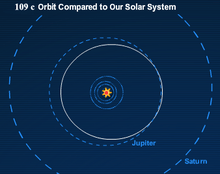OGLE-2006-BLG-109Lc
OGLE-2006-BLG-109Lc is an extrasolar planet approximately 4,920 light-years away in the constellation of Sagittarius. The planet was detected orbiting the star OGLE-2006-BLG-109L in 2008 by a research team using Microlensing. The host star is about 50% the mass of the Sun and the planet is about 90% the mass of Saturn.[1][2]
 | |
| Discovery | |
|---|---|
| Discovered by | Gaudi and Bennett et al. |
| Discovery date | 14 February 2008 |
| Gravitational microlensing | |
| Orbital characteristics | |
| Eccentricity | 0.15 ± 0.1 |
| 4931 ± 1750 d 13.5 ± 4.79 y | |
| Inclination | 64 ± 8 |
| Star | OGLE-2006-BLG-109L |
| Physical characteristics | |
| Mass | 0.271 ± 0.022 MJ (85.8 ± 9.5 M⊕) |
| Temperature | 59 ± 7 |
See also
References
- "Discovery of a Jupiter/Saturn Analog in OGLE-2006-BLG-109". MicroFUN (Microlensing Follow-Up Network). Retrieved 2008-06-27.
- Gaudi, B. S.; et al. (2008). "Discovery of a Jupiter/Saturn Analog with Gravitational Microlensing". Science. 319 (5865): 927–930. arXiv:0802.1920. Bibcode:2008Sci...319..927G. doi:10.1126/science.1151947. PMID 18276883.
External links
- Britt, Robert Roy (2008-02-14). "Solar System Like Ours Found". Space.com. Retrieved 2008-06-27.
- Dominik, Martin (2006-02-11). "The unlonely planets — Discovery of a Jupiter/Saturn analogue". ARTEMiS. Retrieved 2008-06-27.
- Overbye, Dennis (2008-02-14). "Scientists Find Solar System Like Ours". The New York Times. Retrieved 2008-06-27.
- Rincon, Paul (2008-04-06). "Solar System's 'look-alike' found". BBC News. Retrieved 2008-06-27.
This article is issued from Wikipedia. The text is licensed under Creative Commons - Attribution - Sharealike. Additional terms may apply for the media files.